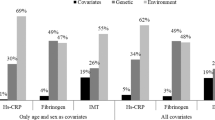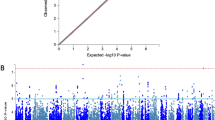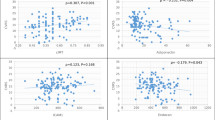Abstract
Carotid intima-media thickness (cIMT) is a subclinical measure of atherosclerosis with mounting evidence that higher cIMT confers an increased risk of cardiovascular disease. The ryanodine receptor 3 gene (RYR3) has previously been linked to increased cIMT; however, the causal variants have not yet been localized. Therefore, we sequenced 339 480 bp encompassing 104 exons and 2 kb flanking region of the RYR3 gene in 96 HIV-positive white men from the extremes of the distribution of common cIMT from the Fat Redistribution and Metabolic Changes in HIV infection study (FRAM). We identified 2710 confirmed variants (2414 single-nucleotide polymorphisms (SNPs) and 296 insertion/deletions (indels)), with a mean count of 736 SNPs (ranging from 528 to 1032) and 170 indels (ranging from 128 to 214) distributed in each individual. There were 39 variants in the exons and 15 of these were non-synonymous, of which with only 4 were common variants and the remaining 11 were rare variants, one was a novel SNP. We confirmed that the common variant rs2229116 was significantly associated with cIMT in this design (P<7.9 × 10−9), and observed seven other significantly associated SNPs (P<10−8). These variants including the private non-synonymous SNPs need to be followed up in a larger sample size and also tested with clinical atherosclerotic outcomes.
Similar content being viewed by others
Log in or create a free account to read this content
Gain free access to this article, as well as selected content from this journal and more on nature.com
or
Accession codes
References
Effros, R. B ., Fletcher, C. V ., Gebo, K ., Halter, J. B ., Hazzard, W. R . & Horne, F. M . et al. Aging and infectious diseases: workshop on HIV infection and aging: what is known and future research directions. Clin. Infect. Dis. 47, 542–553 (2008).
Marchetti, G ., Tincati, C . & Silvestri, G . Microbial translocation in the pathogenesis of HIV infection and AIDS. Clin. Microbiol. Rev. 26, 2–18 (2013).
Brenchley, J. M ., Price, D. A ., Schacker, T. W ., Asher, T. E ., Silvestri, G . & Rao, S . et al. Microbial translocation is a cause of systemic immune activation in chronic HIV infection. Nat. Med. 12, 1365–1371 (2006).
Mogensen, T. H ., Melchjorsen, J ., Larsen, C. S . & Paludan, S. R . Innate immune recognition and activation during HIV infection. Retrovirology 7, 54 (2010).
Shrestha, S ., Irvin, M. R ., Grunfeld, C . & Arnett, DK . HIV, inflammation, and calcium in atherosclerosis. Arterioscler. Thromb. Vasc. Biol. 34, 244–250 (2014).
Lorenz, M. W ., Stephan, C ., Harmjanz, A ., Staszewski, S ., Buehler, A . & Bickel, M . et al. Both long-term HIV infection and highly active antiretroviral therapy are independent risk factors for early carotid atherosclerosis. Atherosclerosis 196, 720–726 (2008).
Hsue, P. Y ., Lo, J. C ., Franklin, A ., Bolger, A. F ., Martin, J. N . & Deeks, S. G . et al. Progression of atherosclerosis as assessed by carotid intima-media thickness in patients with HIV infection. Circulation 109, 1603–1608 (2004).
Robertson, C. M ., Gerry, F ., Fowkes, R . & Price, J. F . Carotid intima-media thickness and the prediction of vascular events. Vasc. Med. 17, 239–248 (2012).
Hurst, R. T ., Ng, D. W ., Kendall, C . & Khandheria, B . Clinical use of carotid intima-media thickness: review of the literature. J. Am. Soc. Echocardiogr. 20, 907–914 (2007).
Lorenz, M. W ., Markus, H. S ., Bots, M. L ., Rosvall, M . & Sitzer, M . Prediction of clinical cardiovascular events with carotid intima-media thickness: a systematic review and meta-analysis. Circulation 115, 459–467 (2007).
Nambi, V ., Chambless, L ., He, M ., Folsom, A. R ., Mosley, T . & Boerwinkle, E . et al. Common carotid artery intima-media thickness is as good as carotid intima-media thickness of all carotid artery segments in improving prediction of coronary heart disease risk in the Atherosclerosis Risk in Communities (ARIC) study. Eur. Heart J. 33, 183–190 (2012).
North, K. E ., MacCluer, J. W ., Devereux, R. B ., Howard, B. V ., Welty, T. K . & Best, L. G . et al. Heritability of carotid artery structure and function: the Strong Heart Family Study. Arterioscler. Thromb. Vasc. Biol. 22, 1698–1703 (2002).
Fox, C. S ., Polak, J. F ., Chazaro, I ., Cupples, A ., Wolf, P. A . & D'Agostino, R. A . et al. Genetic and environmental contributions to atherosclerosis phenotypes in men and women: heritability of carotid intima-media thickness in the Framingham Heart Study. Stroke 34, 397–401 (2003).
Shrestha, S ., Irvin, M. R ., Taylor, K. D ., Wiener, H. W ., Pajewski, N. M . & Haritunians, T . et al. A genome-wide association study of carotid atherosclerosis in HIV-infected men. Aids 24, 583–592 (2010).
Shrestha, S ., Yan, Q ., Joseph, G ., Arnett, D. K ., Martinson, J. J . & Kingsley, L. A . Replication of RYR3 gene polymorphism association with cIMT among HIV-infected whites. Aids 26, 1571–1573 (2012).
Shendre, A ., Irvin, M. R ., Aouizerat, B. E ., Wiener, H ., Vazquez, A. I . & Anastos, K . et al. RYR3 gene variants in subclinical atherosclerosis among HIV-infected women in the Women’s Interagency HIV Study (WIHS). Atherosclerosis 233, 666–672 (2014).
Lynch, A. I ., Irvin, M. R ., Boerwinkle, E ., Davis, B. R ., Vaughan, L. K . & Ford, C. E . et al. RYR3 gene polymorphisms and cardiovascular disease outcomes in the context of antihypertensive treatment. Pharmacogenomics J. 13, 330–334 (2012).
Schork, N. J ., Nath, S. K ., Fallin, D . & Chakravarti, A . Linkage disequilibrium analysis of biallelic DNA markers, human quantitative trait loci, and threshold-defined case and control subjects. Am. J. Hum. Genet. 67, 1208–1218 (2000).
Tien, P. C ., Benson, C ., Zolopa, A. R ., Sidney, S ., Osmond, D . & Grunfeld, C . The study of fat redistribution and metabolic change in HIV infection (FRAM): methods, design, and sample characteristics. Am. J. Epidemiol. 163, 860–869 (2006).
O'Leary, D. H ., Polak, J. F ., Wolfson, S. K. Jr ., Bond, M. G ., Bommer, W . & Sheth, S . et al. Use of sonography to evaluate carotid atherosclerosis in the elderly. The Cardiovascular Health Study. CHS Collaborative Research Group. Stroke 22, 1155–1163 (1991).
Gnirke, A ., Melnikov, A ., Maguire, J ., Rogov, P ., LeProust, E. M . & Brockman, W . et al. Solution hybrid selection with ultra-long oligonucleotides for massively parallel targeted sequencing. Nat. Biotechnol. 27, 182–189 (2009).
Bentley, D. R ., Balasubramanian, S ., Swerdlow, H. P ., Smith, G. P ., Milton, J . & Brown, C. G . et al. Accurate whole human genome sequencing using reversible terminator chemistry. Nature 456, 53–59 (2008).
Li, H . & Durbin, R . Fast and accurate short read alignment with Burrows–Wheeler transform. Bioinformatics 25, 1754–1760 (2009).
McKenna, A ., Hanna, M ., Banks, E ., Sivachenko, A ., Cibulskis, K . & Kernytsky, A . et al. The Genome Analysis Toolkit: a MapReduce framework for analyzing next-generation DNA sequencing data. Genome Res. 20, 1297–1303 (2010).
Wang, K ., Li, M . & Hakonarson, H . ANNOVAR: functional annotation of genetic variants from high-throughput sequencing data. Nucleic Acids Res. 38, e164 (2010).
Chang, X . & Wang, K . wANNOVAR: annotating genetic variants for personal genomes via the web. J. Med. Genet. 49, 433–436 (2012).
Alf, E. F . & Abrahams, N. M . The use of extreme groups in assessing relationships. Psychometrika 40, 563–572 (1975).
Wu, M. C ., Lee, S ., Cai, T ., Li, Y ., Boehnke, M . & Lin, X . Rare-variant association testing for sequencing data with the sequence kernel association test. Am. J. Hum. Genet. 89, 82–93 (2011).
Lanktree, M. B ., Hegele, R. A ., Schork, N. J . & Spence, J. D . Extremes of unexplained variation as a phenotype: an efficient approach for genome-wide association studies of cardiovascular disease. Circ. Cardiovasc. Genet. 3, 215–221 (2010).
Acknowledgements
We thank investigators and staff of the Fat Redistribution and Metabolic Change in HIV Infection (FRAM) study. The FRAM study was supported by NIH grants RO1-DK57508, -HL74814 and -HL53359, K23-AI66943 and UL1 RR024131; NIH GCRC grants M01-RR00036, -RR00051, -RR00052, -RR00054, -RR00083, -RR0636 and -RR00865; the Albert L. and Janet A. Schultz Supporting Foundation and with resources and the use of facilities of the Veterans Affairs Medical Centers of Atlanta, District of Columbia, New York and San Francisco. Sequencing experiments were conducted at HudsonAlpha Institute for Biotechnology, Huntsville, AL and the genetic sub-study was supported by UAB Center for AIDS Research (CFAR; P30 AI027767) developmental project (NIAID Supplement PI: Shrestha).
Author information
Authors and Affiliations
Corresponding author
Ethics declarations
Competing interests
The authors declare no conflict of interest.
Rights and permissions
About this article
Cite this article
Zhi, D., Shendre, A., Scherzer, R. et al. Deep sequencing of RYR3 gene identifies rare and common variants associated with increased carotid intima-media thickness (cIMT) in HIV-infected individuals. J Hum Genet 60, 63–67 (2015). https://doi.org/10.1038/jhg.2014.104
Received:
Revised:
Accepted:
Published:
Issue date:
DOI: https://doi.org/10.1038/jhg.2014.104
This article is cited by
-
Genome-wide associated variants of subclinical atherosclerosis among young people with HIV and gene-environment interactions
Journal of Translational Medicine (2022)



